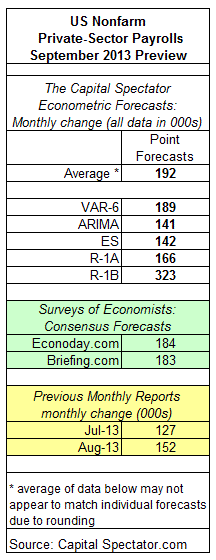The Labor Department’s employment report for September, officially scheduled for release tomorrow, October 4, will be postponed because of the government shutdown. But assuming that the data will be published at some point, private nonfarm payrolls in the US are projected to increase 192,000 (seasonally adjusted) in the September update from the Labor Department, according to The Capital Spectator’s average econometric point forecast. The projected gain is substantially higher than the previously reported increase of 152,000 for August. Meanwhile, The Capital Spectator’s average projection for September is moderately above a pair of consensus forecasts for private payrolls, based on surveys of economists.
Here’s a closer look at the numbers, followed by brief summaries of the methodologies behind The Capital Spectator’s projections:

VAR-6: A vector autoregression model that analyzes six economic time series in context with private payrolls. The six additional series: ISM Manufacturing Index, industrial production, aggregate weekly hours of production and nonsupervisory employees in the private sector, the stock market (S&P 500), spot oil prices, and the Treasury yield spread (10-year less 3-month T-bill). The forecasts are run in R with the “vars” package.
ARIMA: An autoregressive integrated moving average model that analyzes the historical record of private payrolls in R via the “forecast” package.
ES: An exponential smoothing model that analyzes the historical record of private payrolls in R via the “forecast” package.
R-1A: A linear regression model that analyzes the historical record of ADP private payrolls in context with the Labor Department’s estimate of US private payrolls. The historical relationship between the variables is applied to the more recently updated ADP data to project the government’s estimate of private payrolls. The computations are run in R.
R-1B: A linear regression model that analyzes the historical record of initial jobless claims (monthly average) in context with the Labor Department’s estimate of US private payrolls. The historical relationship between the variables is applied to the more recently updated jobless claims data to project the government’s estimate of private payrolls. The computations are run in R.